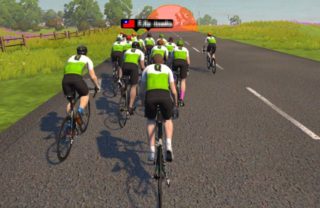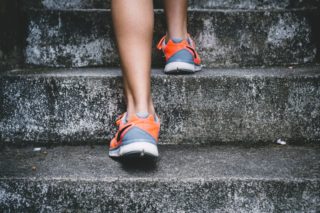A few weeks ago, Garmin data reported early exercise activity tracking trends in the United States. It presented remarkable changes in the types of sports and exercises in which people were choosing to engage. Updated Garmin trend data from other countries shows how lockdown restrictions are impacting in different ways and at different levels.
How the State of Emergency Impacted Activity
On Friday the 13th to be exact, Americans awoke to the news that a national state of emergency had been declared. By Sunday, the CDC had issued an advisory against gatherings of 50 or more people. According to activity tracking data from the millions of registered Garmin users, this fateful weekend in mid-March was a turning point. It marked a major shift in human activity.
With state and local governments issuing shelter-in-place orders, it was no surprise that Garmin data showed a massive decline in the overall number of steps taken during the second two weeks of March. This was an obvious cause-and-effect scenario. It was also consistent with their global trend data in China, Italy and other countries where the pandemic first struck.
A Shift Happened
While the decrease in global movement scratches the surface of what’s happening, the advanced metrics in millions of Garmin wearable devices give Garmin a deeper understanding of exactly how people are dealing with the impact of the pandemic on their active lifestyles. The company is observing a remarkable shift in the types of activities people are doing. They believe it shows an unprecedented about-face when it comes to typical springtime exercise and activity.
Garmin Data Activity Eye Opener
To paint a clear picture of the initial trends, Garmin engineers and data analysts looked at the percent change in activity level in the United States for specific sports and exercises. They compared the first half of March with the second half of March to determine increases and decreases. For further clarity, the results are baselined against the same time period in 2019.

Cyclists back-pedalled into their pain caves
While skiers stay off the mountain, cyclists have evidently back-pedaled into their pain caves to continue their routine. Virtual cycling activity is up 64% in the second half of the month. Garmin says this is an aggressive shift. It appears even more atypical when comparing it to the same time period last year. March 2019 saw a 20% decline in activity as cyclists naturally began to take their rides outside to enjoy the warmer weather.
Rethinking Daily Fitness
Things got even more interesting when Garmin explored what was happening outside of niche sports. They looked at everyday fitness-seekers who’ve been forced to rethink daily workout routines. Indoor/treadmill running and lap swimming are down 44% and 88%, respectively. “On the surface, that sounds like the world has grinded to a halt. However, the full story points to the exact opposite. Big box gyms across the US are closed, with a massive number of treadmills sitting idle.”
In terms of virtual running (performed on a treadmill by linking a Garmin smartwatch to an outside app such as Zwift), Garmin data reflected a steep increase in the second half of March. And despite gym closures, overall indoor cardio held strong. Above 2019 levels. Showing an 18% week-over-week increase from March 16 to March 30.

Finding other ways to stay active
This all seems to suggest one thing: More people are exercising. And they’re finding new ways to do it from home, with and without their own equipment.
This theory is supported by media reports of stores selling out of in-home workout equipment, as people look to bring the gym to them. Furthermore, walking as a logged activity profile (this is a built-in app in Garmin devices) is up 36% when comparing the front half of March to the back half of March.
“This surge is double the 18% increase observed over the same springtime period last year. The numbers validate what most are observing in their own neighbors. Lots of people are walking. Complying with social distancing recommendations. However, walking nonetheless.”
In-home routines are being re-invented
All of this reflects another important real-world observation Garmin data scientists are seeing on social media. They suggest that in-home routines are being reinvented and shared virtually. Fitness retailers and personal trainers offer remote workout solutions. Consumers are challenging each other to continue moving. Garmin also started a #10KADAY step challenge on Instagram to help followers stay active while shelter-in-place orders are in effect.
Yoga on the increase
More and more people are doing yoga. Garmin wearable device data shows an 11% increase, when comparing the front and back halves of the month in yoga and related stretches and poses. Again, another significant increase over the 2019 data. Whether the mats are being rolled out on the living room floor or on front lawns, it’s clear that yoga is becoming an activity of choice.
![Garmin data [longevity live]](https://longevitylive.com/wp-content/uploads/2020/04/photo-of-woman-doing-yoga-2294354-320x214.jpg)
European Experience
More recently, Garmin data analysts looked at Europe. Specifically, for the top five EU countries with confirmed coronavirus cases – Italy, Spain, France, Germany and the U.K. – to gauge the scale of atypicality, Garmin also included Sweden in their data pull. In Sweden, there are significantly fewer restrictions in place and physical distancing enforcement is more minimal.
Garmin is looking at data from millions of Garmin smartwatch wearers and is using their own approach and methodology. They believe reporting only on aggregate step counts does not tell the complete story. While this number is down in every country, they caution against using this data set alone to suggest that people are moving less. This is what Garmin says:
Moving In Quarantine
“Take, for example, a woman who’s quarantined in a 120-square-meter apartment in Italy. While she may be logging a very low daily step count due to physical confinement, she could also be cycling in place on a virtual trainer for 20 kilometres a day. Has her activity level decreased because of the pandemic? No. She’s actually moving more. She’s just changed her routine because of circumstance.
Accuracy, perspective and the ability to dive deeper into the data are critical to painting a true picture of what’s happening in our world. Garmin wearable devices have more than 20 different built-in sports and activity apps. This vast feature set combined with an expansive global user base doesn’t just tell us if people are moving. It tells us how they are moving.”
Now let’s look at the Garmin data
Each activity trend visualization shows six European countries, selected for the aforementioned reasons. National lockdowns began taking effect on March 9 in Italy, with other countries implementing restrictions in the coming days. For a consistent and clear picture, Garmin used March 9 as a midpoint and compared the five weeks prior to and five weeks after to determine percentage increases and decreases. Although not visualized, 2019 trends over the same time period were crosschecked to ensure seasonal trends were differentiated from those driven by COVID-19 related events.
Cycling
Garmin data also tracked changes to indoor cycling. When comparing the pre- and post-lockdown phases in France, Garmin was seeing a remarkable 157% increase in the activity. Spain and Italy are reporting record indoor cycling highs as well, with 273% and 309% increases, respectively. Again, as the Garmin data shows, the magnitude of this shift cannot be understated. The world is witnessing historically steep increases in activity that typically decreases in the spring. It’s never happened before.

Zwift
Garmin says it’s worth noting: “A large portion of indoor cyclists are virtual riding with smart trainers, such as those made by Tacx. This means they’re syncing their activity with a third-party platform such as Zwift, which allows users and their connections to ride together virtually throughout the world. So when you hear platitudes like “staying apart brings us together,” you can rest assured that for cyclists, it really is true.
Additionally, as more people log indoor cycling activities, we’re seeing the average distance per ride increase, which could indicate a newfound motivation to “beat” the impositions of the pandemic. Spain is seeing an incredible 41% average distance per ride increase.”
Indoor cycling instead of skiing
Meanwhile, the data scientists say Germans, despite having a slight decline in the overall activity trend, are still going on longer rides with a 12% average distance per ride increase. The March 1 spike in Sweden correlates with the Vasaloppet ski race – our hypothesis here is that many people were indoor cycling instead, as a proxy for participating in the race.
Outdoor activities
“When we look at outdoor cycling in Germany, the U.K. and Sweden, the trend line indicates a clear movement outside. In Germany alone, we’re seeing a 153% increase in outdoor cycling. During the same time period in 2019, Germany only saw a 36% increase. It’s entirely within the realm of possibility that psychological factors, such as a desire to be more active in the face of adversity, could be at play here. Additionally, this trend line also points out how well stay-at-home orders are being followed in France, Italy and Spain.”
What about the masses?
But what about the masses? After all, not everyone is a cyclist. From this perspective, Garmin data experts turned to fitness equipment activity data. This includes activities uploaded using any of the following built-in profiles on a Garmin device: elliptical workout, indoor cardio, indoor rowing, stair machine and strength training. The results, Garmin explains, are also startling.
Increase in exercise activity
- Italy has seen a 105% increase in fitness equipment activities when comparing the pre- and post- lockdown time periods.
- People in France, Spain and the U.K. are also working out more with categorical increases of 80%, 93% and 8%, respectively.
All of this seems to indicate that those living in countries with the most extreme lockdown restrictions are still finding ways to move.
Golf
If you want to golf, go to Sweden. “In fact, Sweden’s post-winter migration to the courses is even stronger right now than in 2019. The Northern European kingdom is in the midst of an extraordinary 741% increase in golfing activity.”

This figure is even more notable when considering the 26% decrease in the U.K. It’s a place where the popularity of the sport is high, but where the British Open (scheduled for June) was recently cancelled.
Running
And what about running? Garmin data shows it’s the most popular and typically shared springtime activity. In Spain and Italy, where countrywide lockdowns are most extreme, outdoor running has dropped significantly with respective decreases of 68% and 42%.
A deeper dive into the Garmin data shows that people in the countries with the highest restrictions are taking it to the treadmill, and in many cases, virtual running too. Italians, Spaniards and the French are uploading running activities in record numbers, with respective country increases of 130%, 84% and 18%.
Garmin data shows we are getting outside, but differently
So, what’s the deal with runners in Germany, Sweden and the U.K.? “Well, the data tells us that they are still behaving differently. In every country, those who are running outside are running shorter distances. Even Germans, Swedes and British runners, despite having more lax stay-at-home restrictions, are still limiting their outdoor exposure. So while indoor running is on the rise in most places, outdoor running is still happening. It’s just a little closer to home these days.”
Swimming
When we look at the Garmin data for swimming, it’s perhaps most interesting in that the drop-off timeline mirrors the lockdown dates instituted by each country. One by one, as each country announced their specific shelter-in-place orders, their swimmers stopped swimming. Which makes sense. “All of this holds until you get to Sweden, where looser restrictions appear to have resulted in a much more modest decrease in activity.”
Floor Climbing
Garmin data around floor climbing is even more interesting. Not because it’s the first thing you think of when considering physical activity during a global pandemic, but because it’s the last. And according to the Garmin data, it’s happening in Spain, France and Italy. A lot.
“Floor climbing is different from the stair machine activity covered earlier in the fitness equipment activity results. Here we’re referring to people specifically running up and down stairs in their apartments or houses.
No fitness equipment? No problem. We still have stairs
In France, this activity has increased by 103%. In Italy, it’s skyrocketed 572%. And in Spain, climbing stairs has increased by an astounding 900%

Of all the activity trend shifts, this is perhaps the most intriguing and also encouraging. Despite the confinement imposed by shelter-in-place orders, a record number of people are refusing to let their physical health suffer. No fitness equipment? No problem. We still have stairs.”
Beat Yesterday
Fitness is finding a way, despite the fear, anxiety and lack of general outdoor movement of COVID-19. People all over the world are showing that they will move. Despite the challenges and restrictions.
Garmin scientists say the single most important takeaway from the data so far is that people are still moving forward through adversity. “It’s an innate human desire to “beat yesterday.” It truly is an inspiring feat. And one that perhaps carries even more relevance today than ever.”
References
This post was based on content supplied by the Garmin Global Pandemic Reports: Part 1 and Part 11.





![women [longevity live]](https://longevitylive.com/wp-content/uploads/2020/01/photo-of-women-walking-down-the-street-1116984-100x100.jpg)









